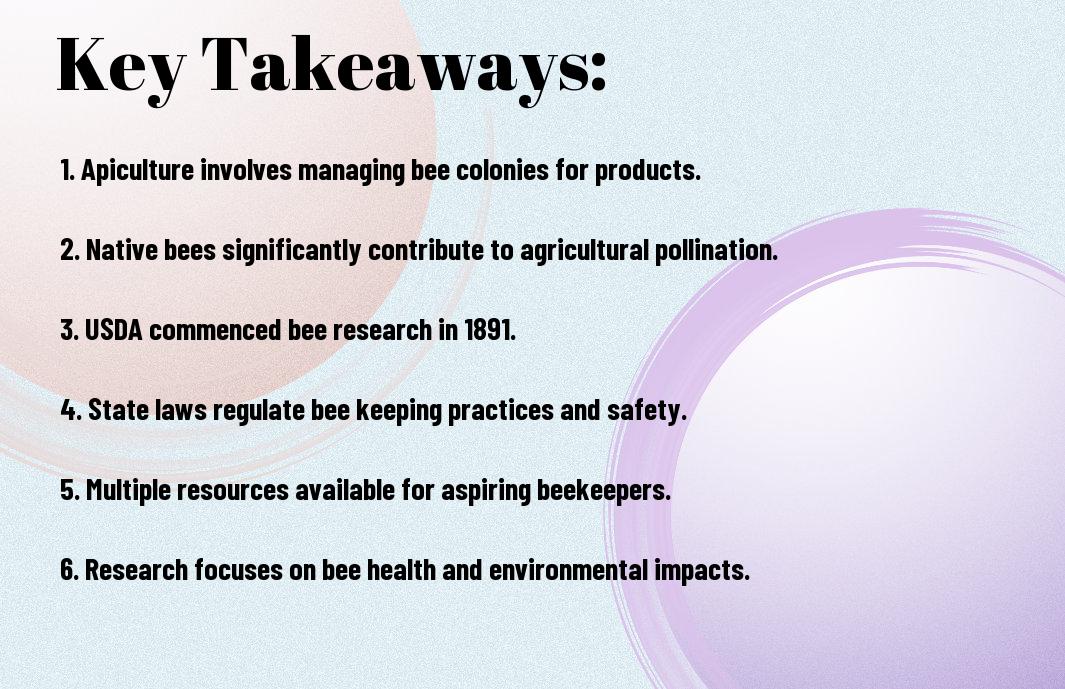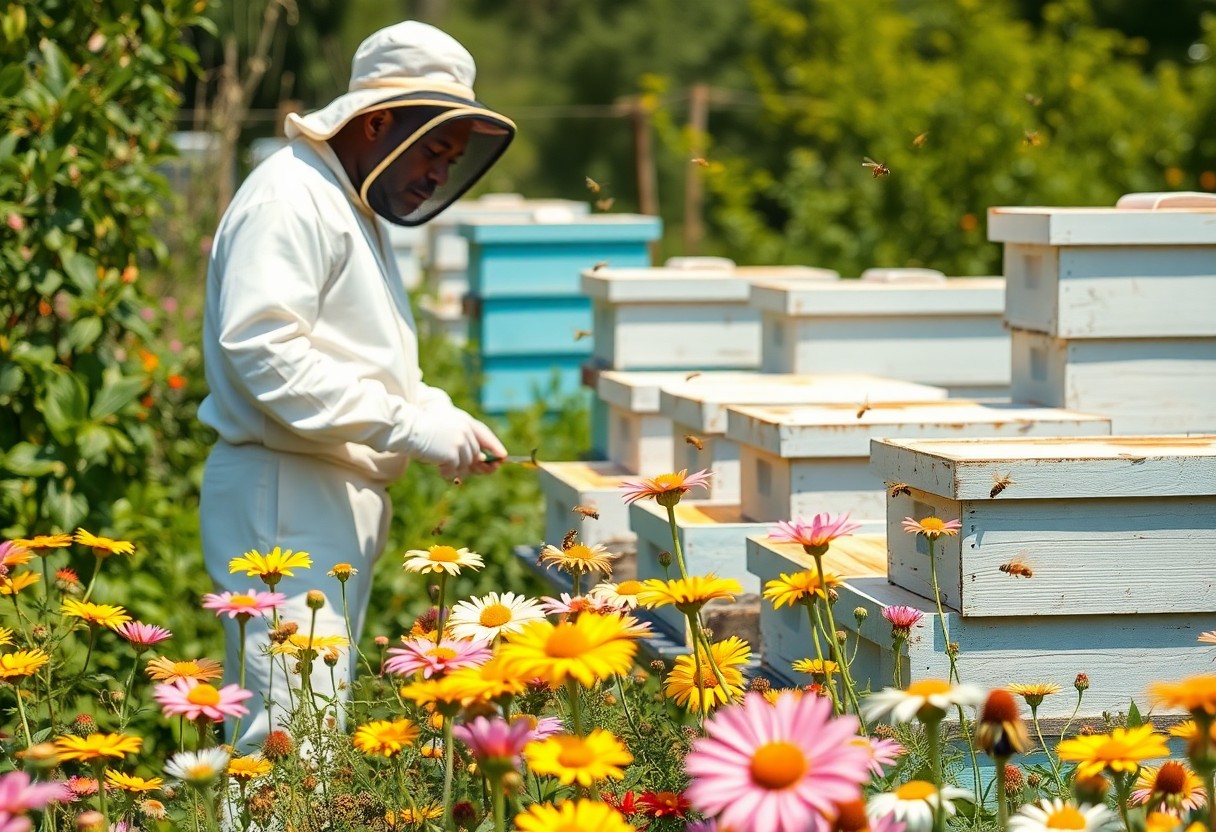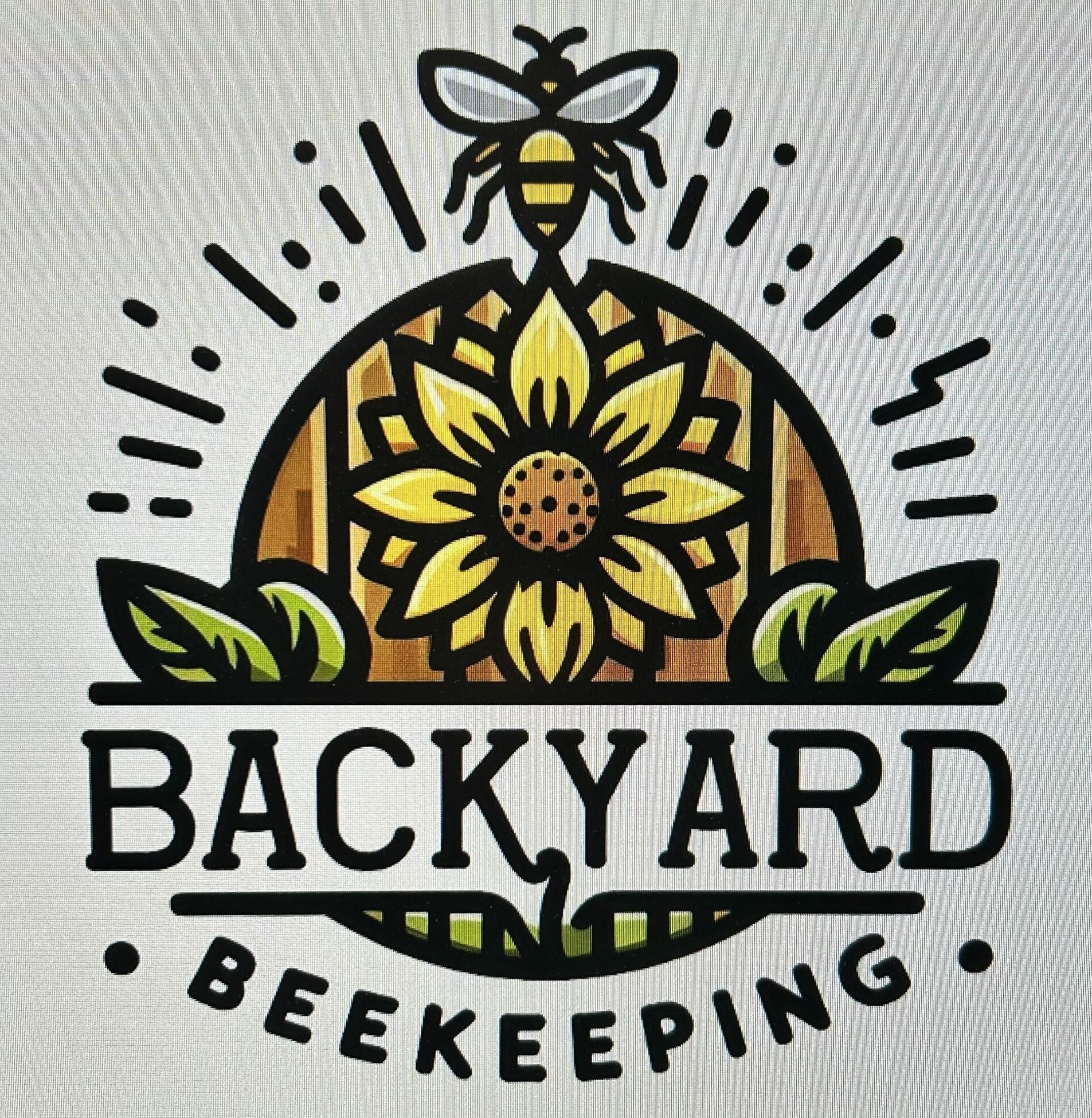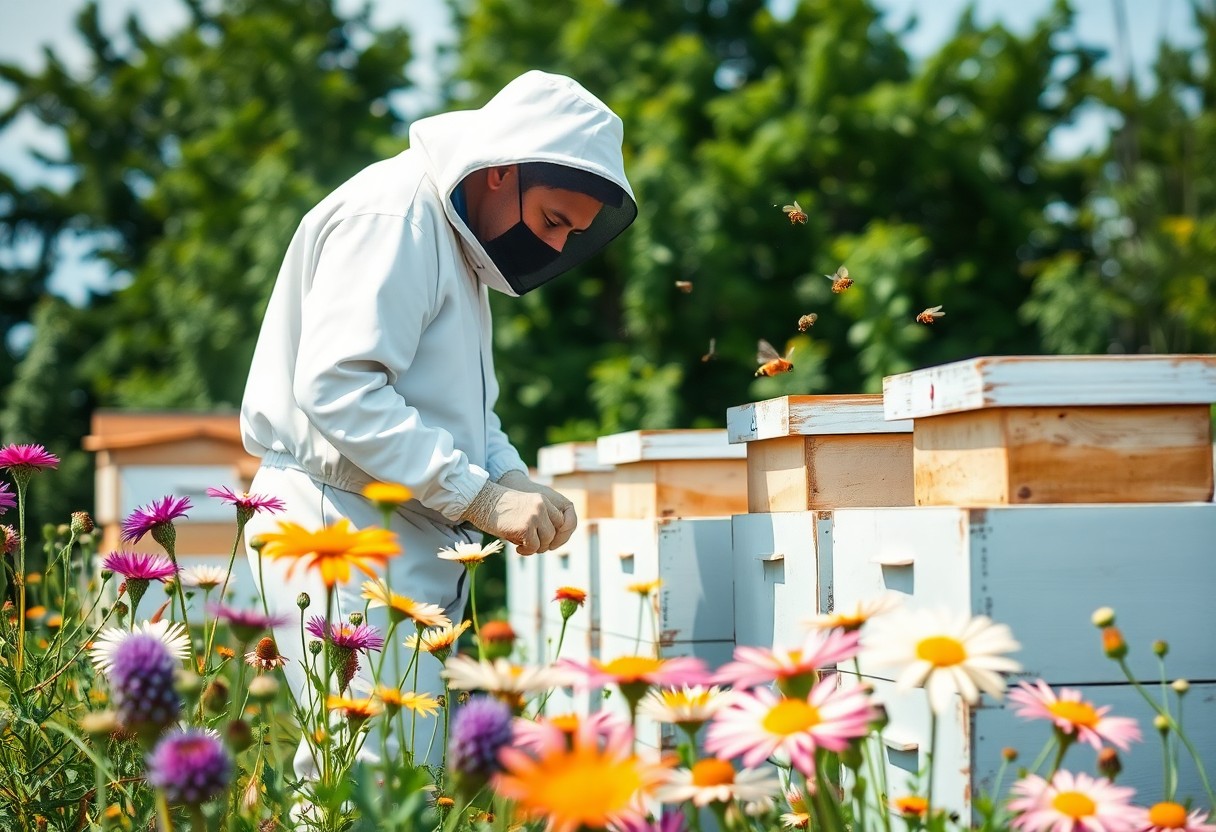Agriculture thrives on the vital roles bees play in pollination and the production of honey and other bee products. As you launch on your journey into apiculture, understanding the science of keeping bees and their historical significance can enhance your beekeeping endeavors. This guide provides necessary resources, expert assistance, and insights into bee management practices, ensuring you have the knowledge to support healthy colonies and contribute to sustainable agricultural practices.

The Importance of Bees in Agriculture
The relationship between bees and agriculture is deeply rooted, shaping the agricultural landscape for thousands of years. As you explore the significance of bees, it’s vital to understand that these remarkable insects play an imperative role in pollinating various crops, which directly influences food production and biodiversity. The history of our interaction with bees dates back at least 17,000 years, indicating a longstanding reliance on their natural abilities to support agriculture. While honey bees dominate current agricultural practices, it’s noteworthy that they were not native to North America; they were introduced in the 17th century from Europe, transforming how agriculture was practiced in this region.
Historical Context of Bees and Agriculture
Among the early civilizations, bees and honey were highly valued for their nutritional and medicinal properties. You might be interested to learn that the earliest evidence of sophisticated bee management emerged nearly 14,000 years ago, well before the establishment of modern agriculture. This historical context illustrates how integral bees have always been in supporting agricultural practices, shaping not only traditional farming but also contemporary methods.
Pollination Benefits
With over 4,000 native bee species in North America, bees significantly contribute to the pollination of numerous crops and plants. As you examine deeper into agricultural practices, you’ll notice that many fruits, vegetables, and nuts directly depend on insect pollination for successful production. The efficiency of these pollination activities dramatically increases yields, ensuring a steady food supply and promoting agricultural diversity.
Bees are responsible for pollinating approximately one-third of the food that you consume daily, highlighting their immense value in your diet. From apples to almonds, their role is indispensable, leading to healthier ecosystems where a variety of plants can thrive. By supporting pollination, bees play a vital part in maintaining the structure and function of agricultural landscapes.
Economic Impact of Bee Products
Against the backdrop of agricultural economics, the contributions of bees extend beyond pollination to include a range of valuable products such as honey, beeswax, and propolis. Each year, the economic benefits attributable to honey production and pollination services amount to billions of dollars in the United States alone. These products not only enhance your culinary experiences but also support various industries, from food production to cosmetics and pharmaceuticals.
Due to the significance of these products, many farmers and beekeepers rely on bees as integral to their livelihoods. The interdependence between agriculture and beekeeping creates a beneficial cycle that bolsters local economies. As you can see, recognizing the importance of bees in agriculture can cultivate a greater appreciation for their vital role in sustaining both the environment and economic vitality.
Overview of Apiculture
Assuming you have an interest in apiculture, it’s crucial to understand that beekeeping is not just a leisurely hobby but a significant agricultural practice that supports ecosystems and food production. Beekeepers manage colonies of honey bees and other species to sustain bee populations and harvest natural products. It involves a blend of scientific knowledge and practical skills, including understanding bee behavior, hive management, and environmental considerations.
Definition and Basics of Beekeeping
Between the growing public interest in local, sustainable practices and the vital role bees play in agriculture, beekeeping has become increasingly popular. You start by establishing a bee colony, which typically requires assembling a hive, acquiring bees (usually via a package or a nucleus colony), and selecting an appropriate location that meets the environmental needs of the bees. As you develop your skills, you’ll learn about variations in hive structures and methods of honey extraction, enabling you to effectively manage your hive and produce valuable products.
The Role of Honey Bees vs. Native Bees
Definition of bee roles in your garden can significantly impact your understanding of apiculture. While honey bees are well-known for their honey production and strong colonies, over 4,000 native bee species in North America also play critical roles in pollination. These native bees, often solitary and less visible than honey bees, help fertilize plants, contributing to biodiversity and the health of ecosystems.
Understanding the distinction between honey bees and native bees expands your perspective on the importance of both groups in agriculture and natural habitats. Honey bees, though non-native to North America, are integral to large-scale crop pollination, while native bees enhance local ecosystems through diverse pollination activities.
Types of Bee Products
Basics of bee products range from honey to wax, each with its unique benefits and uses. You may find that honey is the most well-known product, celebrated for its sweetness and nutritional value, but bees also produce royal jelly, propolis, and bee pollen, each comprised of distinct properties that serve both culinary and medicinal purposes. Understanding these products can help you appreciate the economic and health benefits associated with apiary products.
| Bee Product | Description |
| Honey | A sweet substance made by bees from nectar. |
| Beeswax | Natural wax produced by bees for building honeycomb. |
| Propolis | A resinous mixture used by bees to seal their hive. |
| Royal Jelly | Nutrition-rich substance fed to queen larvae. |
| Bee Pollen | Protein-rich substance collected from flowers. |
Any of these products can enrich your dietary and wellness practices, showing the value of maintaining bee populations. The diverse uses of bee products make them significant not only economically for beekeepers but also for consumers seeking natural options for health and nutrition.
More on Types of Bee Products
At the same time, every product from bees holds unique properties that may benefit you in various ways, enhancing your lifestyle choices or contributing to traditional remedies. The range of bee products available allows you to explore new culinary experiences and boosts your health through natural sources that bees provide.
| Bee Product | Potential Uses |
| Honey | Sweetener, medicinal, soothing properties. |
| Beeswax | Cosmetics, candles, food preservation. |
| Propolis | Antimicrobial, protective for health purposes. |
| Royal Jelly | Energy booster, skin treatments. |
| Bee Pollen | Protein supplement, allergen relief. |
Any interest you have in apiculture can lead you to explore these fascinating products and their diverse applications, strengthening your connection with nature and enhancing your well-being.
Early History of Beekeeping
Many people are unaware of the long-standing relationship humans have had with bees, which dates back at least 17,000 years. This ancient bond is illustrated through archaeological discoveries that showcase honey hunting and the early harvesting of bee products. For example, evidence suggests that humans were collecting honey from wild hives even before the development of agriculture, highlighting the integral role bees played in early human diets. As you research into the history of apiculture, you’ll come across various records that elucidate how this practice evolved over millennia.
Archaeological Evidence
The ancient ties between humanity and bees are well-documented through a variety of archaeological findings, including ancient murals and artifacts. These findings indicate that bees were not only prized for their honey but also for other products such as wax, which was used in many applications from candle-making to waterproofing. You may find it intriguing that the earliest depictions of humans engaging in honey hunting occurred around 4,000 years before our first agricultural systems were established, demonstrating the significance of bees in early societies.
Furthermore, archaeological sites from different parts of the world reveal insights into the evolution of beekeeping techniques. As you explore these contexts, you will see how ancient cultures depended on bee products for sustenance and medicinal purposes, laying the groundwork for the sophisticated apiculture practices we have today.
USDA’s Initial Focus on Beekeeping
With the establishment of the USDA in 1862, the United States recognized the importance of bees in agriculture. The agency began its beekeeping research in 1891 at the Bee Research Laboratory in Beltsville, Maryland. This was a pivotal moment, as it marked the start of a structured approach to studying bees and their vital role in pollination and agriculture. The USDA’s focus has broadened significantly since then, culminating in the cooperative efforts with other federal organizations to enhance bee health and productivity.
Even today, the USDA continues this important work through various initiatives and collaborations that seek to improve the resilience and well-being of bee populations across the country. Their extensive research programs have shaped policies that ensure sustainable beekeeping practices, helping beekeepers like you to manage your hives more effectively while contributing to the ecosystem.
Notable Historical Publications
Historical publications on beekeeping provide valuable insight into the evolution of apiculture practices. The works of early authors, such as Thomas Hill and Charles Butler, are among the foundational texts on honeybee husbandry and underscore the knowledge that has been passed down through generations. These early writings not only discuss practical techniques but also reflect the cultural significance of bees in society. As you explore these publications, you’ll gain a deeper appreciation for the expertise that has shaped modern beekeeping methodologies.
In fact, these pivotal texts offer a glimpse into the challenges and triumphs faced by beekeepers in the past. They serve as a historical backdrop that informs current practices and emphasizes the need to combine traditional knowledge with contemporary research. By understanding this rich history, you can apply these lessons to your own beekeeping journey.
Starting Your Own Hive
Unlike many hobbies, beekeeping provides not only personal satisfaction but also significant contributions to local ecosystems through pollination and the production of honey. As you begin on your journey into apiculture, being well-prepared with the right knowledge and equipment can make all the difference in successfully managing your bee colony.
Essential Equipment and Setup
Above all, investing in crucial equipment is foundational to starting your own hive. You will need a beehive, which usually comes in various configurations, including Langstroth or Top-Bar hives, depending on your preferences and capabilities. Additionally, items such as protective gear, bee feeders, hive tools, and a smoker are vital for safe and effective hive management. Ensure you set up your hive in a location that is sunny, sheltered from strong winds, and provides easy access to nectar and pollen sources for your bees.
Best Practices for Hive Maintenance
Hive inspections are crucial for maintaining healthy bee colonies. Regularly checking for signs of diseases, pests, or hive health issues allows you to address problems before they escalate. Ensure that your bees have adequate food supplies, especially during periods of low forage availability. Monitoring the population density and checking for queen activity are also important practices. Proper maintenance not only supports the overall health of your colony but also enhances honey production, which can be quite rewarding.
Further, approaching bee management with a commitment to sustainability can significantly affect your success. Consider integrating Integrated Pest Management (IPM) strategies to control pests and diseases without relying heavily on chemicals. This not only promotes healthier bee populations but also supports the broader ecosystem in your area, ensuring that your beekeeping practices are in harmony with nature.
Resources for New Beekeepers
For new beekeepers, numerous resources across federal, state, and local levels are available to help you navigate the complexities of apiculture. The USDA and local extension offices often provide valuable insights, workshops, and best practices tailored to your specific region. You might also find community beekeeping groups to connect with fellow enthusiasts and share experiences. Access to the latest research is also crucial in staying informed about bee health and regulations that might affect your hive.
A wealth of online resources can enhance your learning journey. Websites of beekeeping associations and agricultural extensions often host informative materials ranging from beginner guides to advanced beekeeping techniques. Engaging with these resources will help you build a strong foundation and foster an enduring relationship with your bees as you learn to raise them effectively.
Regulatory Considerations
Keep in mind that engaging in beekeeping involves navigating various regulations established by states and local jurisdictions. These laws are designed to ensure the health and safety of both your bee colonies and the surrounding community. Different states may have specific guidelines regarding hive management, disease control, and interaction with local ecosystems. Therefore, it’s important for you to consult with local beekeeping associations and your State Department of Agriculture for a comprehensive understanding of the applicable laws where you live.
State and Local Laws for Beekeeping
On a local level, beekeeping regulations can vary significantly from one area to another. Some municipalities may require you to register your hives, while others may impose restrictions on hive placements to ensure public safety and minimize any potential nuisances. This may involve setbacks from property lines, limits on the number of permitted hives, or requirements for maintaining adequate distances from populated areas. It is advisable to check with your local zoning and agricultural authorities to obtain the most current information on these laws.
Always ensure that you are in compliance with these regulations to avoid fines or the potential for legal issues. Staying informed about the specific requirements in your area not only helps you protect your investment and interests as a beekeeper but also fosters positive relationships with your neighbors and community members.
Health and Safety Regulations
Considerations for health and safety are vital when it comes to beekeeping. As a beekeeper, you are responsible for maintaining the wellbeing of your bee colonies, which includes being aware of any potential health threats such as pests and diseases. Additionally, there are considerations regarding the handling of hive products, particularly honey, which must meet specific health standards to ensure it’s safe for consumption. Understanding these regulations helps to promote responsible beekeeping practices.
Regulatory bodies, like the USDA, emphasize the importance of adhering to protocols that minimize risks such as pesticide exposure or hive infections. Engaging in regular inspections and being proactive about monitoring the health of your bees will not only comply with regulations but also enhance the success of your beekeeping endeavors.
Zoning and Permitting Information
Regulations surrounding zoning and permitting for bee colonies can be complex and influenced by land use policies in your area. Depending on where you live, you may need to obtain specific permits to keep bees on your property, especially if you reside in urban or suburban areas. Understanding these zoning laws is vital to ensure that your beekeeping operations do not infringe on local ordinances and that you can manage your hive effectively within those boundaries.
With careful research and communication with local authorities, you can navigate the zoning and permitting process successfully. This will ensure that your beekeeping practices are not only compliant with local laws but also supported by the community, contributing to a positive and sustainable environment for both bees and people alike.

Research and Resources
To navigate the world of apiculture effectively, it’s vital to tap into the vast array of research and resources available through the USDA and other relevant institutions. These resources not only help you understand the current state of bee populations but also guide you in best practices for managing your hives. Whether you are a novice or an experienced beekeeper, leveraging this information can enhance your beekeeping efforts and contribute to the sustainability of bee populations.
Current USDA Research Initiatives
Between the challenges posed by pests, diseases, and environmental stressors, the USDA is continuously focused on initiatives aimed at improving bee health and supporting beekeeping practices. Their research priorities encompass diverse areas, including the study of genetics and biology, environmental stressors, and nutritional needs. By understanding these facets, you can implement strategies that promote healthier bee colonies and potentially increase honey yields.
In addition to bee health, current USDA initiatives also address the economic impact of beekeeping. Through targeted research, they aim to bolster the resilience of bee populations and explore sustainable practices that benefit both beekeepers and the agricultural sector at large. This holistic approach ensures that you have access to relevant data and strategies that promote effective management of bee colonies.
Accessing Bee-Related Databases and Tools
About your journey in apiculture, taking advantage of available databases and tools can significantly enhance your knowledge and skills. Platforms like Ag Data Commons and Data.gov provide access to a wealth of open data related to beekeeping and bee health. These resources allow you to explore trends, identify challenges, and craft informed strategies for your beekeeping endeavors.
For instance, by utilizing these databases, you can obtain information on native and honey bee populations, hive health, environmental impacts, and effective management practices. Such data can guide you in making informed decisions that benefit your beehives and contribute positively to your local ecosystem.
Relevant Publications and Reports
Reports spanning various areas of apiculture are published regularly, offering you insights into the latest research findings and trends in bee management. Resources such as the USDA Annual Strategic Pollinator Priorities Report present a comprehensive overview of crucial areas like nutrition, pest management, and environmental stressors impacting bee health. Engaging with these publications will not only provide you with vital knowledge but also keep you updated on the evolving science of beekeeping.
Understanding the multitude of reports available can illuminate best practices and innovative approaches in your beekeeping journey. These materials, accessible through USDA channels, can serve as foundational resources as you develop your expertise and adapt your practices in this vital field of agriculture.
Challenges Facing Beekeepers
Not all aspects of beekeeping are straightforward, and as a beekeeper, you will encounter several challenges that can impact your hives and their overall health. Understanding these challenges is vital for successful apiculture and for ensuring that your bees thrive.
Pests and Pathogens
After years of research, it’s been well-documented that pests and pathogens represent significant threats to bee populations. The Varroa destructor mite, for example, is a pervasive parasite that infests honey bee colonies, causing considerable damage and even leading to colony collapse if not managed effectively. In addition to Varroa, other pathogens such as Nosema and various viruses can weaken your bees, making them more susceptible to these pests and further compromising their health.
It’s vital for you to regularly inspect your hives and be vigilant in identifying signs of infestations or disease. Implementing integrated pest management strategies, such as maintaining colony hygiene and employing natural remedies or targeted treatments, can help mitigate the risks posed by these adversities.
Environmental Stressors
With a variety of environmental stressors, your bees face challenges that can affect their health and productivity. Climate change, habitat loss, and pesticide exposure can all contribute to the decline of bee populations. Alterations in weather patterns can disrupt blooming periods of flowers, making food sources unavailable for your bees. Additionally, losses of natural habitats due to urban development and monoculture practices reduce the nutritional diversity vital for the well-being of your colonies.
Environmental factors can significantly influence the forage available to your bees. Understanding these dynamics and being proactive can help you develop strategies to provide adequate resources for your colonies, thereby improving their chances of survival and productivity.
Trends in Bee Populations
One of the concerning trends in recent years has been the decline in bee populations across the United States. Data from the USDA National Agricultural Statistics Service indicates that honey bee colonies have been experiencing significant losses, with factors such as habitat loss, pesticide exposure, and pest infestations contributing to this trend. As a beekeeper, being aware of these statistics can help you stay informed about the challenges your colonies may face.
This decline is not only detrimental to the bees but also poses risks to agriculture and food production, as bees play a vital role in pollinating many crops. Keeping abreast of trends in bee populations and advocating for policies that support pollinator health can be beneficial for both your bees and broader agricultural interests.
To Wrap Up
Conclusively, your interest in apiculture and beekeeping opens up a world of knowledge and opportunity. Whether you’re drawn to the ancient relationship between humans and bees, the myriad benefits they provide such as honey and wax, or the vital role they play in agriculture, engaging with this field can lead to fulfilling contributions to both environmental sustainability and local economies. With the resources available through the National Agricultural Library and various USDA initiatives, you have access to a wealth of information that can enhance your understanding and practice of beekeeping.
As you venture into beekeeping, consider the importance of adhering to local regulations and seeking guidance from experts who can support your journey. Your actions can positively impact bee populations and agricultural practices, fostering a healthier ecosystem. Embrace the journey of cultivating your own beehive and becoming part of the ongoing narrative of apiculture; it is a venture that not only enriches your life but also benefits the community around you.

